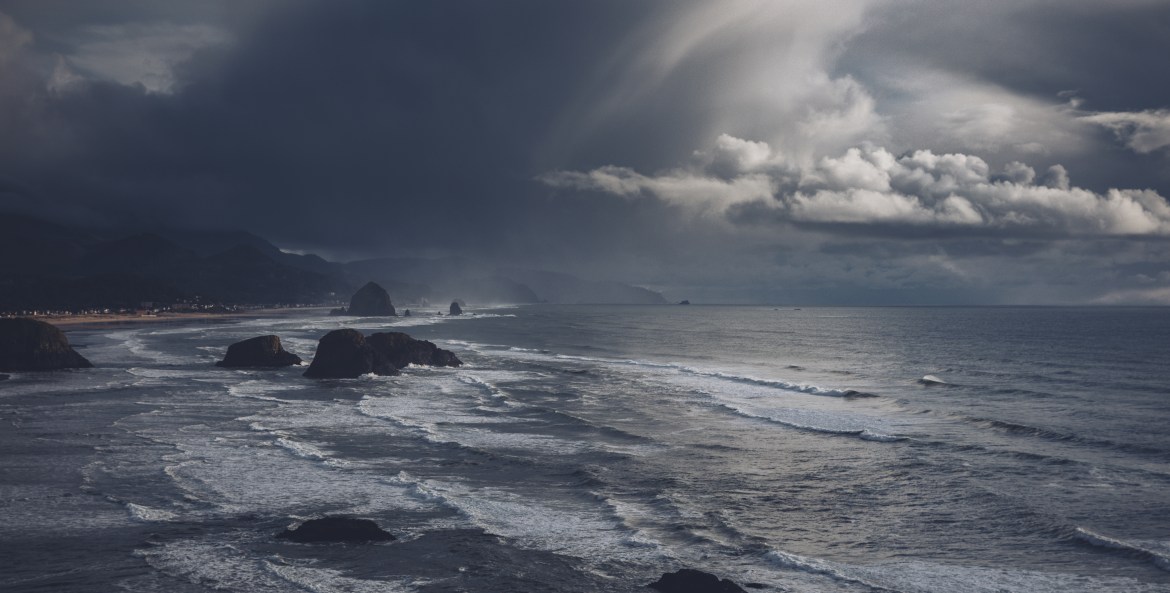One blustery evening in January 1999, I trekked down the central Oregon Coast to watch a spectacularly awful storm blow in. I found I was not alone. Every single room at Heceta Lighthouse Bed & Breakfast—a former coastal beacon—had been booked by fellow wild-weather nuts. The next morning, over house-made crab cakes and banana bread, the only topic of conversation was when the storm would peak. The plates were cleared and, tingling with anticipation, we ascended the lighthouse's spiral staircase. Sideways rain slammed the tower, wind gusts sent shivers through the walls, and metallic echoes reverberated around us. As we stepped outside, cold, hard droplets pelted our faces and hands and feet and arms. We smiled. This was what we came for.
It's not new—the tradition of grabbing the camera and heading to land's end to witness the Northwest's wild winter weather—but it is trending. Each year, our ever-growing GoreTex–clad tribe gathers at the edge of the Pacific, from Vancouver Island down to Mendocino, California, to watch the storms crash in. According to one survey, Oregon and Washington residents ranked storm watching among their five favorite coastal recreation activities. In my own experience, I've noticed that the number of foul weather enthusiasts is steadily rising.
Years after that trip to Heceta Head, my wife and I were nearly stranded in Manzanita, Oregon, when a series of storms unloaded almost a foot of tropical moisture and closed roads for several days. We fled when we heard the National Weather Service issue a warning of a big storm with hurricane-force winds. But the diehards who hunkered down for the ride still talk about the Great Coastal Gale of 2007, when wind gusts topped 120 miles an hour and heavy rains caused 17 rivers to flood. Vancouver, Washington, resident Dave Elson understands this fascination with meteorological mayhem. "It sets a mood that you get swept up in, something you can't ignore while it's happening," he says.
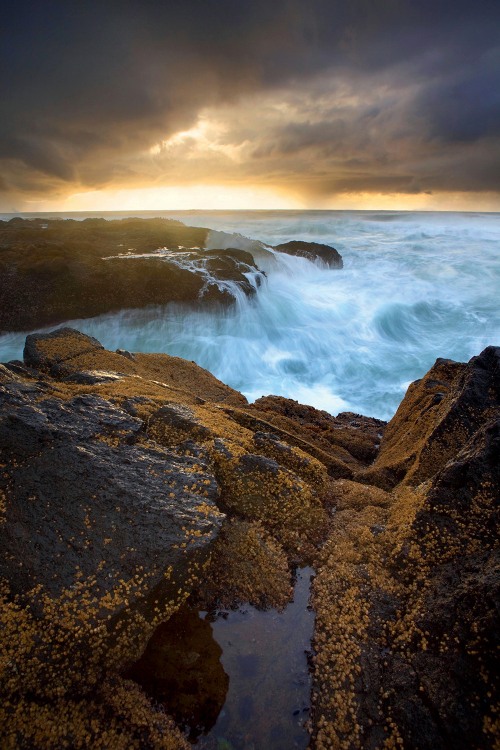
The 804 Trail, in Yachats, Oregon, provides panoramic views of the Pacific.
Elson certainly can't ignore storms, since his job is to predict weather for Oregon's coastal waters as a meteorologist at Portland's National Weather Forecast Office. Last winter, on a busman's holiday, he made it out to Ecola State Park near Cannon Beach in time to photograph waves enveloping Tillamook Rock Lighthouse. "The lighthouse stands a hundred feet tall," Elson says, "and I watched it entirely disappear into spray. That was awe inspiring."
Only the biggest, fiercest gales earn names—the Columbus Day Storm of 1962 still sets the standard against which all coastal blows are measured—but it's rare for a Northwest winter to pass without wind gusts of 60 miles an hour and 30-foot waves pummeling the shore. Peter Ruggiero, a professor of geology and geophysics at Oregon State University, explains, "The Oregon Coast, with its extensive expanse of ocean to the west, has the most extreme wave climate in the continental United States."
"We get waves generated in the Southern Hemisphere that can take two weeks to arrive—and even bigger waves whipped up in the Gulf of Alaska," he says. "We're in the bull's-eye."
We're also, if we care to be, in pampered luxury. Today, seaside hotels catering to storm watchers provide cantilevered floor-to-ceiling windows, sheltered decks, and even jetted hot tubs perfectly angled to take in the chaos outside. And thanks to increasingly accurate long range forecasts, we can time our foul-weather jaunts around the entire arc of a big blow. We can head coastward to watch the advance battalion of swells heralding cyclogenesis (the development of a low-pressure system) or the perfectly curling plungers that break as that system roars onshore; we can come for the fierce white spray as the wind crescendoes or for the eerie shafts of sunlight that pierce the dissipating black clouds as the storm breaks up. Pity the poor tornado chaser rattling down some rutted dirt road in pursuit of a skittish funnel cloud, while we Pacific storm aficionados toast 25-foot breakers from the oceanfront dining room of a snug seaside inn.
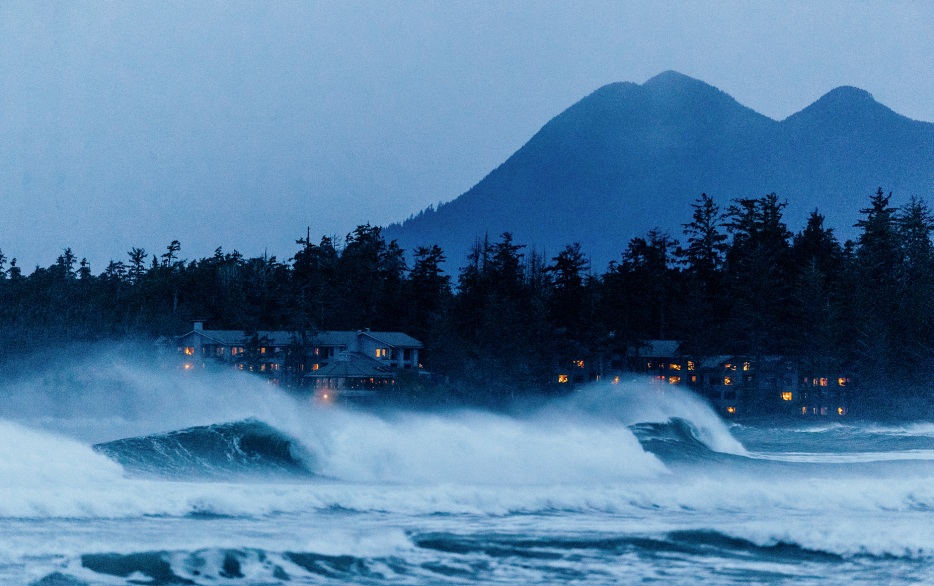
The waves that crash outside British Columbia's Wickaninnish Inn can reach heights of 31 feet.
Though the jury is still out on how exactly climate change will alter coastal weather patterns, there's no question that a warming atmosphere and ocean will make marine weather more extreme—causing higher sea levels, more beach erosion, heavier rainstorms, and, very possibly, bigger waves. With today's sophisticated predictive models, a big "bomb" (the rapid deepening of an area of low pressure that signals a burst of high winds) rarely catches us unawares anymore—but science still hasn't ironed all the mystery out of intense weather. Our coastal storms are as varied as a toddler's moods: Some lift after a single violent tantrum; some whine for six hours, rage for another six, then weep through the night; others hang around moping for days.
Of course, planting yourself in the path of wicked weather bears some obvious risks. But luckily for storm watchers, elevated vantage points such as headlands, promontories, and bluffs are not only safer than beaches, they also command better views of the 20-to-30-foot waves that everyone wants to capture on film. Ruggiero, the geology professor, explains this phenomenon as an interaction between wave structure and coastal topography. "Due to the gradual incline of our coastline," he says, "often the really powerful waves break far from shore, and closer in you get this violent cacophony of white water." For the best views of unmarred swells, he recommends standing on an outcropping that forces the waves to break right near shore, such as Yaquina Head or Cascade Head.
A poet could compose a resounding ode just from the names of our prime storm-watching eminences: Cape Disappointment (at the mouth of the Columbia); Cape Flattery (at the tip of Washington's Olympic Peninsula); Cape Foulweather, Yachats, Heceta Head, Boiler Bay (on the central Oregon Coast). Ideally, such a verse would be penned in the thick of a howling gale on the deck of Canada's fabled Wickaninnish Inn, or in a spray-soaked cabin at Washington's Kalaloch Lodge, while gazing over the roiling Pacific.
But you don't have to be a poet to wax rhapsodic about the majesty of Northwest coastal storms. Listen to Marshall Nelson, a lawyer who has watched decades of storms roll in from the deck of his home near Arch Cape, Oregon: "In the city, you can hear and see a storm—but on the coast, you're in the middle of it. There is something almost mystical in how small we are in the face of nature." —David Laskin
Where to Watch the Waves
Powerful weather fronts create huge whitecaps and frothing surf along the coast each winter, inspiring storm fanatics to bear witness. Just remember, as you watch the water, never to turn your back on the ocean. Offshore squalls can cause sneaker waves, which push huge masses of water onto shallowly sloped beaches. These swells can flood coves, wash over high rocks, and transform beached logs into deadly weapons. To stay safe, watch the action from up on the headlands or inside a welcoming eatery. Here are six top storm-watching spots on the Oregon Coast.
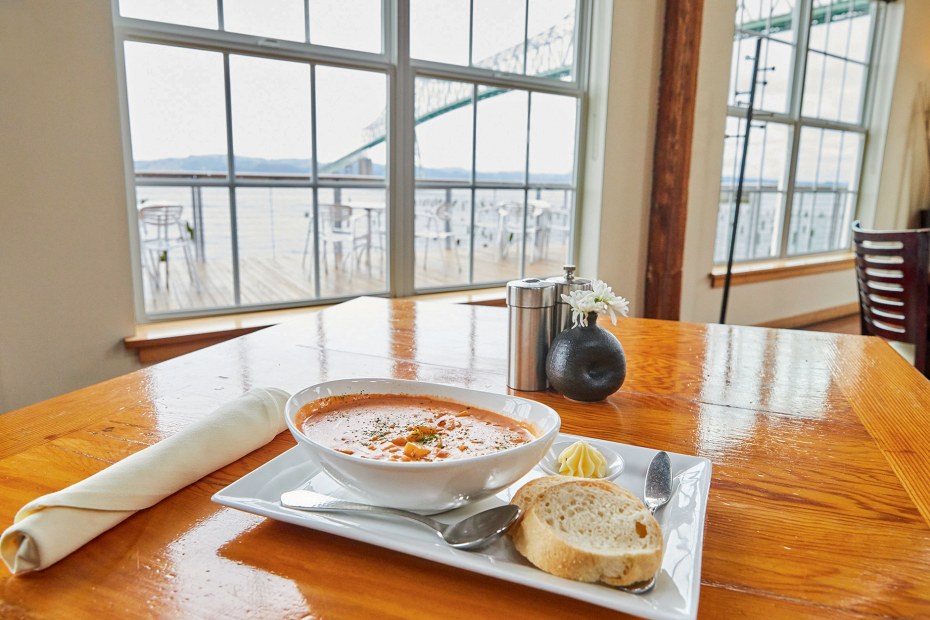
Bridgewater Bistro.
- The Columbia River laps up against the patio at Astoria's Bridgewater Bistro. Inside, tall windows look out onto the Astoria-Megler Bridge and the cargo ships passing beneath it, bound for distant lands. As you speculate on their destinations, warm up with the unusual clam and mussel chowder, a slightly spicy fusion with a touch of curry, basil, and tomato.
- Walking into the Horn Public House & Brewery—a Depoe Bay gastropub named for an epic blowhole—you would expect an epic ocean vista. Aptly, from the top floor, you can see waves crashing against the town seawall. Pair the view with a pint of the housebrewed Sea Witch Icelandic Porter. Don't miss the wings: Braised in Moby Red Ale, they're perfect with a basket of crunchy tots dressed in roasted red pepper ranch.
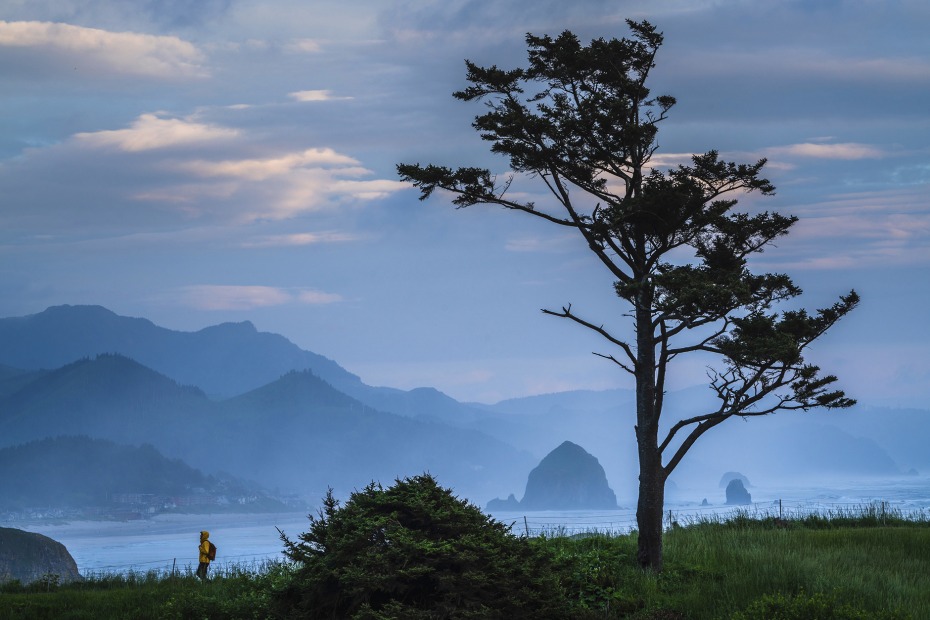
Ecola State Park.
- Giant waves break along the cliff-hugging road from Shore Acres State Park to Cape Arago State Park, Oregon's most revered storm-watching site. Stand at the Simpson Reef Overlook between the two parks and—no matter how loud the wind is howling—you can hear the melodic barks of thousands of seals and sea lions emanating from nearby Shell Island.
- With 1,000-foot-high cliffs and few tall trees to block the sight lines, Ecola State Park is a legendary place to watch dark clouds approach the coast. Take in the action from two viewpoints not far from the Ecola Point parking lot: one oriented south over Indian Beach, and another near Terrible Tilly, a chilling lighthouse that's slowly crumbling to ruin.

Meridian Restaurant.
- Even on the breathtaking Three Capes Scenic Loop, a 40-mile drive along the Tillamook County coast, Cape Meares State Scenic Viewpoint stands out. Craggy 200-foot cliffs jut up from the turbulent water, and an 1890 lighthouse perches on the coastline. Its deck offers a perfect vantage point to watch the surging surf pound the southern coast. A path from the south side of the parking lot leads to a centuries-old Sitka spruce nicknamed the "Octopus Tree" whose massive branches spiral out like tentacles.
- Chef John Nelson of Pacific City's Meridian Restaurant draws inspiration from the local catch. As you tuck into, say, petrale sole with citrus beurre blanc, look outside. You'll see Haystack Rock standing tall in the surging tide. —Jennifer Burns Bright
